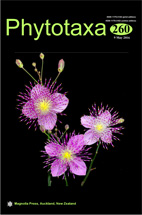Abstract
Two microfilamentous green algal specimens from Tibet were identified as Ctenocladus circinnatus Borzi, due to their unique morphology and saline habitat. The phylogenetic evidence based on DNA sequence data from the nucleus (SSU) and chloroplast elongation factor TU (tufA) sequences clearly revealed that the genus Ctenocladus, which has been classified in the Chaetophorales (Chlorophyceae) or Trebouxiophyceae incertae sedis by most phycologists, should be included in the Ulvales (Ulvophyceae) instead, and has a close relationship with the genera Pseudendoclonium and Phaeophila. We speculate that there may be undescribed or cryptic species especially in freshwater and other non-marine habitats. A phylogenetic re-evaluation based on large samples of microfilamentous ulvophycean algae especially freshwater specimens is needed.

